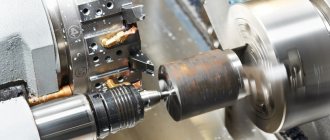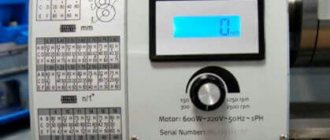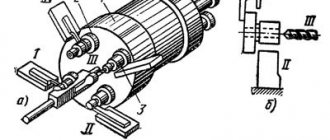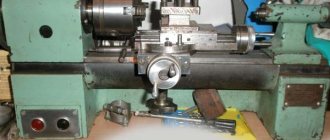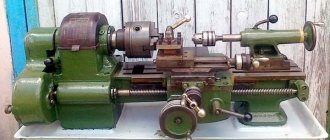Purpose and scope
A new model of the machine replaced the TV-4, a more outdated unit. Even with a simplified design, the TV-6 machine has all the necessary components of conventional screw-cutting devices.
It is equipped with a 6-speed spindle, 4 feed speeds into the caliper, and involves cutting metric threads without the need to rearrange the gears in the guitar.
TV-6 is suitable for tracking types of work:
- Grooving and boring of cylindrical and conical surfaces.
- End trimming.
- Segment.
- Metric thread cutting.
- Drilling.
Technical characteristics of TV-6
Below are the main parameters of the machine in question:
- machining diameter above the caliper - 80/125 mm (in direct/reverse cams);
- circle passing above the bed - 200 mm;
- linear processing size - 300/350 mm (stroke/workpiece);
- the maximum thickness of the processed rod is 12 mm;
- the spindle mounting hole is Morse taper No. 3, the tailstock retractable quill is No. 2;
- workpiece revolutions - 130 - 700 per minute (6 stages);
- automatic longitudinal feed (per revolution of the spindle shaft) - 0.08 - 0.12 mm (3 steps);
- metric threads cut on a machine have pitches of 0.8, 1.0 or 1.25 mm.
- drive electric motor - 1.1 kW, 1440 rpm;
- dimensions, mm: length - 1100, width - 470, height - 1100;
- weight - 300 kg.
Structural elements
The unit has a classic layout characteristic of this type of equipment. The main elements include:
- Front and tailstock.
- Feed box.
- Supporting frame.
- Replacement guitar.
- With protective casing and screen.
- A device that regulates the supply of lubricants.
- Availability of an apron.
Each element is located in its usual place, certain parts can be replaced and replaced during maintenance.
Apron
An apron is necessary for feeding the caliper from the running roller (screw) mechanically or manually. If you need to feed manually, you should rotate the flywheel, which is located on the pinion shaft. The latter connects with the gear, which is located on the shaft of the rack and pinion gear.
A worm connected by a sliding key to a roller provides mechanical feed. It transmits the movement to the worm gear. From there, the movement is transmitted to the rack and pinion gear through the next gear and cam clutch. The jaw clutch is connected to a handle, the rotation of which leads to mechanical feed.
Control diagram
The control diagram has:
- A handle that sets the rotation speed of the spindle assembly.
- Another handle that sets the rotation speed of the spindle assembly.
- A handle that sets thread cutting (right and left) and changes the direction of feed.
- A handle that sets the feed rate and thread pitch.
- A handle that switches the roller.
- Reversing button that turns the machine on and off.
- Lever protecting the cartridge.
- Availability of a protective screen.
- Handle securing the cutting head.
- Light source for illuminating the workplace.
- A handle that manually moves the cross slide.
- A handle that moves the upper (incisor) slide.
- The handle that secures the quill.
- A handle that secures the tailstock towards the bed.
- Flywheels that move the quill.
- A button that turns the rack and pinion gear on and off.
- Flywheels that manually move the longitudinal carriage.
- A handle that adjusts the nuts in the lead screw.
- A handle that includes the maximum mechanical gear.
- Protective shield in front of the lead screw and shaft.
- Availability of transformer OSZR-0.063–83UHL3.
Equipment
The machine assumes a basic configuration, discussed in detail below.
Cabinet
There is a front and rear cabinet.
The first has a U-shape and stiffening ribs in the lower and upper parts of the device.
The front cabinet has a reversing button on the body, which is responsible for turning the electric motors on and off.
There is a drive electric motor in the rear cabinet. It also has a U-shape, inside there is electrical equipment with a shield.
Feedbox and guitar replacement gears
An equally important element of the unit, the feed box and the guitar, their key features are discussed below:
- A set of interchangeable gears is used to change thread parameters.
- The feed box is driven by the gearbox using gears in the transmission mechanism, which includes:
- two shafts;
- five gears with different parameters;
- running roller;
- coupling;
- round nuts;
- shift handle;
- drain plug.
`
The handles on the feed box body determine the cutting parameters for workpieces. Another lever turns on the drive shaft of the unit.
Important!
The feedbox does not require special maintenance, only the presence of lubricant in the gear area for their full functioning.
Headstock and tailstock
The main element of any machine is the headstock and tailstock. Their main features and purposes are listed below:
- The purpose of the headstock is to locate the spindle assembly with the gearbox.
- I use the tailstock to secure centers; they are used to support the end surfaces of large products. Thanks to the use of the center, it is possible to significantly increase the accuracy of work.
Also, through the headstock, access to the gearbox and guitar is provided, which allows you to adjust the cutting parameter.
Apron device
The apron is part of the device that houses the slide, which is responsible for the smooth movement of the caliper. It is made of steel.
The apron structure consists of:
- handwheel;
- rack and pinion gear;
- shaft;
- worm gear;
- uterine nut;
- running roller.
Caliper design
The support secures cutting tools for ease of processing and moves it while working with metal. Four carriages form the basis of the caliper design.
In the fourth carriage, the tool holder fixes the working tools. It moves towards the third carriage, but only longitudinally.
Rotary carriage No. 3 is attached to the second carriage, the latter, in turn, is attached to the first, moving transversely.
The caliper has its own characteristics:
- It securely holds the cutting tool.
- It is located in a certain position in relation to the workpiece.
- Can move in longitudinal and transverse directions.
The support significantly expands the functionality of the machine.
How to buy a used machine
The easiest way to buy a used device is to go to the website for free advertisements for sale in the Russian Federation: Avito.ru. Unfortunately, despite the abundance of advertisements, there may not be enough choice for a particular region. There are other online selling resources. For example, the regional website “From Hand to Hand”. There are also weekly newspapers with the same or similar name. You can submit a purchase ad yourself.
- Warning: when buying from an ad in another region, you may end up with unscrupulous sellers. Or the product may not meet the declared condition, or they will offer a higher price. As a result, money for the trip will be thrown away. So it's better to look for an offer closer.
What to pay attention to when purchasing:
- Availability of chuck, jaws, tailstock, electric motor. Moreover, if the electric motor can still be purchased, then the tailstock is quite difficult to get (they are often sold for scrap metal, since they can be removed from the machine quite easily).
- It is necessary to make sure that the machine spindle rotates and the slide movement is activated. If the electric motor does not work, you can rotate the spindle manually using the drive pulley. If something doesn't rotate or move, there is obviously something wrong.
- Check how worn the rubbing surfaces are, as well as the radial chatter of the spindle and tailstock quill. Any fault found is a reason to reduce the price. If there are many faults, it is better to refuse the purchase even for a small amount. Because repairs can cost a pretty penny.
That's all that can be said in one article. Additional information can be found on thematic forums. It turns out that there are many people who enjoy learning the craft of turning and share their practical experience. Unfortunately, statements are sometimes controversial. In doubtful cases, it is better to seek advice from an experienced professional turner.
Features of use
Even though the TV-6 device is considered a training device, when working on it you can obtain high accuracy and work with complex turning operations. The drive mechanism of the unit uses a V-belt drive, so regular checking of the belt tension is required.
With such a simple preventive measure, maximum power of the electric motor is used and the service life of the work is extended. When the tension is loosened, it is easy to adjust the belts by loosening the nuts and setting the required tension level.
Another common malfunction of the device is vibration when the spindle assembly rotates, due to the loosening of the screw connection. In such a situation, more qualified repairs are required, in case of possible bearing failure.
If gaps are detected in the spindle, grinding of the ends is necessary. But only in the case of minor gaps of a radial and axial nature.
Important!
The machine is highly reliable; with proper care, the unit will last for many years, providing maximum accuracy.
Differences between TV-6 and TV-4
There are no fundamental differences in the design of the two machines. Some changes are listed below:
- The drive power has been slightly increased (from 1 to 1.1 kW).
- Due to the fact that the gear module in the KS has been increased (1.5 instead of 1.25 for the TV-4), the speeds have changed slightly, although, in fact, they remained in the same range.
- The machine became 34 cm shorter, but 8 cm taller. Apparently, the designers took into account teenage acceleration in the 70s of the last century.
- The diameter of the through hole in the spindle was reduced by 3 mm in order to increase its rigidity.
- The conical hole in the spindle has been enlarged to accommodate a fixed center (Morse No. 3).
- The machine has acquired a standard protective fence for the working area.
- The stroke of the upper slide has been increased: 85 mm instead of 50.
- The weight of the machine increased by 20 kg: 300 versus 280 for the TV-4.

